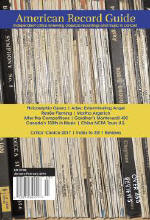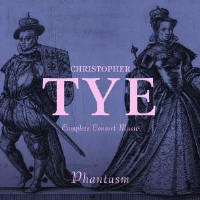Texte paru dans: / Appeared in:
|
|
|
Outil de traduction ~ (Très approximatif) |
|
|
Reviewer: William
J. Gatens In his notes to this recording, Laurence Dreyfus, director of the viol consort Phantasm, expounds on the eccentricities in the consort music of Christopher Tye (c1505-73). 31 pieces survive complete, and they are all here. They abound in audacious dissonance and daunting complexities of rhythm and meter. It is worth remembering that such music was intended primarily for the delectation of the players, and each would have only a single part without bar lines, so that the total musical picture could be comprehended only by hearing what the others were playing and keeping tenaciously to the pitches and rhythms of one’s own part. Five parts form the standard complement in Tye’s consort pieces, but there survive one each in three, four, and six parts. Of these pieces, 21 are examples of that quintessentially English genre, In Nomine. There are two more by Tye that do not survive complete. All such pieces derive from the sixpart Mass Gloria Tibi Trinitas of the 1520s by John Taverner. It is a cantus firmus mass based on the Sarum plainsong melody of that antiphon. In the Benedictus of the mass (“Benedictus qui venit in Nomine Domini”), Taverner reduces the parts to four at the words “In Nomine”, with the cantus firmus in long equal note values. It is a mystery why this particular passage gave rise to at least 150 instrumental compositions ranging chronologically from Thomas Preston (d after 1559) to Henry Purcell. The fact that they are called In Nomines confirms the reference to Taverner’s mass. It appears that Tye composed more pieces in this genre than anyone else. Many have cryptic subtitles like “Say so”, “Follow me”, and “Seldom seen”. Other pieces based on plainsong include four on the responsory Dum Transisset Sabbatum and one each on Christus Resurgens and O Lux Beata Trinitas. It is possible that these originated as vocal motets, and it is worth noting that the boundaries between vocal and instrumental music were not as firmly fixed in the mid 16th Century as they later became. Even untexted music might as likely be sung to solfege syllables as played by instruments, though some of these plainsong-based works of Tye exceed normal vocal ranges. There are pieces with sacred titles but not based on plainsong: ‘Amavit eum Dominus’, ‘Rubum quem’, and ‘Laudes Deo’. Finally there is the three-part ‘Sit Fast’, an amazingly intricate work based on ostinato figures that Dreyfus describes as “orderly but never predictable”. There are several very fine viol consorts currently active, but if I had to pick a favorite, it would be Phantasm. Their playing is technically unimpeachable, and their warm tone is beautifully recorded here with every part distinctly audible. What I find most admirable is their keen sense of forward movement and phrase trajectory. At the same time they maintain that quality of conversation among friends that I believe to be the essence of consort music. | |
|
|
|
|
Cliquez l'un ou l'autre
bouton pour découvrir bien d'autres critiques de CD |
|




